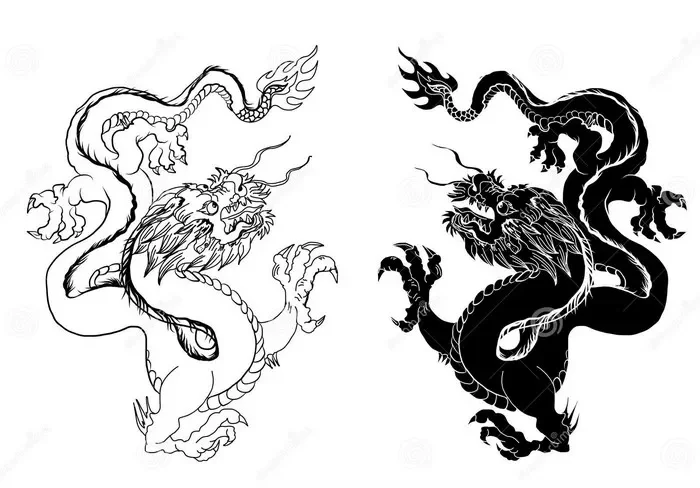Dragon tattoos have long fascinated enthusiasts around the world, especially those featuring the iconic creatures from Chinese and Japanese cultures. While both cultures revere dragons, their representations, meanings, and artistic styles differ significantly. This article explores the distinctions between Chinese and Japanese dragon tattoos, delving into their historical backgrounds, symbolism, artistic features, and cultural significance.
Historical Context
1. The Chinese Dragon
The Chinese dragon, known as “Long” (龙), is a legendary creature deeply embedded in China’s history and mythology. Believed to be a symbol of imperial power, the Chinese dragon is associated with water and agriculture, often seen as a bringer of rain and good fortune. The earliest records of dragons in Chinese culture date back to the Neolithic period, and they have evolved in significance through various dynasties.
2. The Japanese Dragon
The Japanese dragon, or “Ryū” (竜), has its roots in Chinese mythology but has developed a unique identity over centuries. Introduced to Japan via Chinese texts and Buddhism, the Japanese dragon symbolizes strength, protection, and the natural elements. Over time, it has become an integral part of Japanese folklore and art, often depicted in various forms, such as water dragons and earth dragons.
Symbolism
1. Chinese Dragon Symbolism
Power and Authority: The Chinese dragon is a symbol of imperial power. Emperors often identified themselves as dragons, associating their rule with strength and authority.
Good Fortune: Known for bringing luck and prosperity, Chinese dragons are considered guardians against evil spirits.
Harmony with Nature: As water deities, they are linked to rain and agriculture, embodying the balance between humanity and nature.
2. Japanese Dragon Symbolism
Strength and Protection: Japanese dragons are often seen as protectors, warding off evil and bringing good fortune to those who honor them.
Elemental Forces: Unlike their Chinese counterparts, Japanese dragons are often associated with specific elements, such as water, wind, and earth, reflecting their ties to nature.
Transcendence and Spirituality: In some myths, Japanese dragons can transform into other creatures, representing the potential for growth and spiritual enlightenment.
Artistic Styles
1. Chinese Dragon Tattoos
Design Features: Chinese dragons are typically long, serpentine creatures with four legs. Their designs often include intricate details, such as flowing manes, vivid scales, and powerful claws. They may be surrounded by clouds or waves, emphasizing their connection to water.
Color Palette: Traditional Chinese dragon tattoos often feature bold colors, such as red, green, and gold. Red represents good fortune, while gold symbolizes wealth and prosperity.
Cultural Motifs: Common motifs in Chinese dragon tattoos include phoenixes, koi fish, and lotus flowers, which enhance the symbolism and visual impact of the design.
2. Japanese Dragon Tattoos
Design Features: Japanese dragons are often depicted with three claws, and their bodies may be shorter and more muscular compared to Chinese dragons. Their designs tend to be dynamic, often incorporating swirling elements like wind or water.
Color Palette: Japanese dragon tattoos typically use a more muted color palette, with shades of blue, black, and gray, often complemented by vivid reds and greens.
Cultural Motifs: Japanese dragon tattoos frequently incorporate other traditional elements, such as cherry blossoms, waves, and tigers, each adding layers of meaning to the overall design.
Cultural Significance
1. Chinese Dragon in Culture
Festivals and Celebrations: The Chinese dragon is a prominent figure in festivals like the Lunar New Year, where dragon dances are performed to invoke good luck and prosperity for the coming year.
Imperial Emblems: Historically, the dragon served as a symbol of the emperor, with the “Five-Clawed Dragon” representing the highest rank of royalty.
2. Japanese Dragon in Culture
Folklore and Legends: Japanese dragons feature prominently in folklore, often appearing as benevolent figures that assist heroes or protect communities. They are also associated with water deities, reflecting their role in agriculture and fishing.
Art and Tattoo Traditions: Japanese dragon tattoos are a staple of traditional irezumi (Japanese tattoo art). They are often inked in large, elaborate designs that cover significant portions of the body, emphasizing their cultural importance.
Choosing Between a Chinese or Japanese Dragon Tattoo
1. Personal Connection
When deciding between a Chinese or Japanese dragon tattoo, consider your personal connection to the symbols and meanings behind each. Reflect on what resonates with you—whether it’s the imperial power of the Chinese dragon or the protective nature of the Japanese dragon.
2. Artistic Preferences
Evaluate your aesthetic preferences. Chinese dragon tattoos often feature intricate details and vibrant colors, while Japanese dragon tattoos may lean toward a more muted, flowing style. Choose the design that speaks to your artistic taste.
3. Cultural Awareness
Understanding the cultural significance of each dragon type is crucial. Ensure that you respect and honor the traditions and meanings behind the tattoo you choose. Consider discussing your choice with a knowledgeable tattoo artist who can guide you in making an informed decision.
Conclusion
Chinese and Japanese dragon tattoos offer rich symbolism and stunning artistry, each with unique historical backgrounds and cultural significance. By understanding the differences between these two powerful creatures, you can choose a tattoo that resonates with your personal beliefs and aesthetic preferences. Whether you lean toward the auspicious power of the Chinese dragon or the protective spirit of the Japanese dragon, both options provide a meaningful connection to ancient traditions and a striking addition to your tattoo collection.
Related topics:

